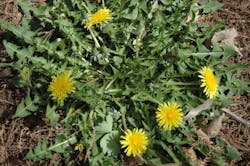The relationship between humans and dandelions (Taraxacum officinale) is complicated. While some people appreciate dandelions for their vibrant color and medicinal properties, these perennial broadleaf weeds can cause issues for vegetation managers responsible for maintaining bareground results throughout utility substations and other sites where total vegetation control (TVC) is required.
The gravel that covers substation floors protects grids of grounding wires for high-voltage equipment. Any vegetation that develops near this infrastructure can compromise grid safety functions and service reliability while posing an electrical hazard to on-site personnel. That’s why utility vegetation managers and their contract partners work to keep substations clear of all grasses, broadleaf weeds and noxious or invasive plants throughout the year — and dandelions are no exception.
Equipped with strong roots that can break through the toughest of soils, dandelions can grow in soil temperatures as low as 50 degrees Fahrenheit, allowing them to thrive nearly anywhere there’s soil and sun. To make matters worse for vegetation managers, dandelions flower quickly, and a single plant can produce up to 2,000 seeds. These seeds can be easily dispersed by wind, and a 10- to 14-day germination period can lead to widespread infestations in a matter of weeks.
Dandelions also can attract animals to utility substations. Songbirds, quail, wild turkeys, rabbits, chipmunks and other wildlife species consume dandelions for their seeds and nutrients. When these animals venture onto a substation floor in search of food, they jeopardize their own safety as well as the reliability of utility service.
How to Control Dandelion Plants Effectively
Hand-pulling dandelions isn’t recommended throughout utility substations for multiple reasons, including:
- Strong taproots may damage wires when pulled
- Pulling plants near live equipment threatens worker safety
- Any taproots that remain intact can lead to regrowth and recurring maintenance needs
In addition to helping on-site personnel avoid these issues, herbicide applications can help vegetation managers control dandelions wherever bareground results are required. In fact, Corteva Agriscience offers Piper® EZ herbicide to help industry professionals eliminate dandelions before and after they emerge each year.
Preemergence Applications
For preemergence ground treatments on all soil types (up to 5% organic matter), apply 16 to 20 fluid ounces per acre (fl oz/A) of Piper EZ herbicide. Preemergence applications of Piper EZ herbicide must be completed prior to weed emergence. While dry weather following application may reduce treatment efficacy, Piper EZ herbicide will control dandelions and other susceptible germinating weeds when adequate moisture is received after dry spells.
Postemergence Applications
The most effective postemergence weed control with Piper EZ herbicide occurs when the product chemistry is applied in combination with a surfactant to dandelions or other weeds less than 2 inches in height. For optimum results, apply Piper EZ herbicide thoroughly at 16 to 20 fl oz/A by ground with an adjuvant (0.25% v/v nonionic surfactant or 1 quart per acre of crop oil concentrate). The addition of an adjuvant enhances the activity of Piper EZ herbicide on emerged weeds.
Applications featuring Piper EZ herbicide and tank-mix partners, such as TerraVue® herbicide from Corteva Agriscience, can provide months-long residual and postemergence activity after targeted species have emerged earlier in the year.
For more information on Piper EZ herbicide, tank-mix partners and other innovative bareground solutions that serve as the backbone of successful TVC programs, visit BetterBareground.com.
™ ® TerraVue is a trademark of Corteva Agriscience and its affiliated companies. Piper® is a trademark of Valent U.S.A. LLC. Under normal field conditions, TerraVue® is nonvolatile. TerraVue has no grazing or haying restrictions for any class of livestock, including lactating dairy cows, horses (including lactating mares) and meat animals prior to slaughter. Label precautions apply to forage treated with TerraVue and to manure and urine from animals that have consumed treated forage. Piper EZ and TerraVue are not registered for sale or use in all states. Contact your state pesticide regulatory agency to determine if a product is registered for sale or use in your state. Consult the label for full details. Always read and follow label directions.
Sponsored By:



